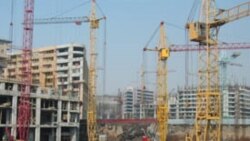By Ruzanna Khachatrian
An ongoing construction boom, the driving force behind Armenia’s double-digit economic growth, has also contributed to the dramatic strengthening of the national currency, the head of the Armenian Central Bank said on Monday.The Armenian dram has gained more than 40 percent in value against the U.S. dollar since December 2003 and is continuing to appreciate, hurting domestic manufacturers and many people dependent on cash remittances from their relatives working abroad. The process has sparked opposition allegations that the Armenian authorities have been deliberately boosting the dram to siphon off a large part of those remittances and to benefit wealthy government-connected importers.
The authorities, backed by the International Monetary Fund and the World Bank, strongly deny any exchange rate manipulation. The Central Bank has said all along that dram’s strengthening has primarily resulted from recent years’ increase in hard currency wired home by hundreds of thousands of Armenians living abroad. Their total amount is expected to exceed $1 billion this year.
According to the bank’s chairman, Tigran Sarkisian, the rapidly growing construction sector is also responsible for the exchange rate fluctuations. Official figures show the sector expanding by more than 40 percent during the first half of this year. The growth is particularly visible in central Yerevan where dozens of expensive apartment blocks are currently under construction.
“Today 45 buildings are being constructed in the center of Yerevan alone,” Sarkisian told hearings on the issue held at the Armenian parliament. “Their dollar-based market value varies from $20 million to $25 million.”
The growth of Armenia’s construction sector is good for everyone, including the low-income stratum of the population which is getting jobs, high salaries,” he added.
Trade and Economic Development Minister Karen Chshmaritian, who also attended the hearings, acknowledged that Armenian manufacturers increasingly have trouble competing with imported goods and selling their production abroad. “Of course the stronger is inflicting damage [on the manufacturing sector,]” he told RFE/RL.
But Chshmaritian insisted that Armenia’s industrial output, excluding polished diamonds, has not shrunk as a result. He said local exporters can offset negative effects of the dram’s strengthening by improving their management and becoming more competitive.
But Suren Bekirski, director of the export-oriented textile company Tosp, disagreed, warning that it risks facing bankruptcy. “As a local manufacturer selling goods here, I gain something [from the stronger dram],” he told RFE/RL. “But as an exporter, I lose twice as much … If things go on like this, we will last for only a few more months.”
According to official data released by the State Customs Committee on Monday, Armenia’s net exports fell by more than 6 percent to 296 billion drams ($777 million) while imports rose by 16 percent to 573 billion drams ($1.5 billion) during the first nine months of the year.
The customs chief, Armen Avetisian, downplayed the increased trade deficit, saying that the physical volume of Armenian goods sold abroad was the same as during the same period last year. He claimed that the monetary value of the exports has decreased mainly due to a drop in international prices of some of Armenia’s key exports such as diamonds, molybdenum and even gold.
(RFE/RL photo)




